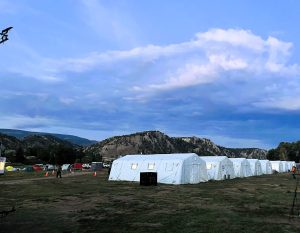Eagle County Census data shows growth, downvalley migration
Populations of Eagle and Gypsum grew by 15.4% and 24.1% while Vail and Avon saw decreases

Eagle County officials are in the process of analyzing the county’s raw data from the 2020 U.S. Census and will soon report their findings to county staff and commissioners. Here’s what we know so far.
The county’s overall population increased by 3,534 residents or 6.8% over 2010 numbers for a total of 55,731 residents, said Amy Keeley, who manages Eagle County’s geographic information systems department.
The new total is only slightly above the county’s 2019 population estimate, and the county’s growth rate is on par with the rest of the region, according to data published by the Colorado Department of Local Affairs. The Northern Front Range region saw the largest growth with a 24.5% population increase reported for Larimer and Weld counties.
Downvalley boom
The bulk of Eagle County’s growth took place downvalley, while towns in the eastern end of the county reported reductions in population size, Keeley said. The populations of Eagle and Gypsum grew by 15.4% and 24.1%.
“Eagle and Gypsum just have been growing,” she said. “There’s been developments occurring since 2010, new neighborhoods.”

Support Local Journalism
Overall, the census results showed 4,835 residents in Vail, 257 in Red Cliff, 1,033 in Minturn and 6,072 in Avon. Downvalley, Eagle now reports a population of 7,511 and Gypsum is at a whopping 8,040, according to data provided by Keeley.
The portion of the town of Basalt that lies within Eagle County reported 2,917 residents.
Census data for local unincorporated areas like EagleVail and Edwards is not yet available, Keeley said.
The town of Vail saw the largest reduction in its population, an 8.9% decrease, but Avon also reported a 5.8% decrease.
Some of this decrease could be due to the fact that the census count began at the start of the COVID-19 pandemic when Vail Resorts and other tourism-driven businesses were shutting down and furloughing or laying off employees, Keeley said.
“We had a lot of Vail Resorts employees that were leaving the county, especially up in the Avon and Vail area,” she said.
Vail and Avon also have more second homeowners and short-term rentals and less affordable housing, she said. It is likely that the cost of living in the upper valley has continued to drive residents farther west in search of affordable housing.
For now, Keeley’s department has only analyzed total population data from the census. Soon, they will have more data to dive deeper into demographic information and population changes in specific neighborhoods, she said.
“We are starting to look at the commissioner district boundaries since they’re 100% dependent on the 2020 census population data,” Keeley said.
Impact of the pandemic
Eagle County saw a decrease in its census response rate from 40.9% in 2010 to 38.6% in 2020.
This roughly 2% decline only accounts for the response rate among residents who took the census online of their own volition, said Abby Dallmann, the county’s special projects manager. It does not account for those who responded to the census through a visit from a census taker.
Either way, there was certainly a decline in responses as the 2020 census was not without its challenges, Dallmann said.
The most obvious of these challenges was the COVID-19 pandemic, which hit the United States just as census efforts were starting up in mid-March, she said. Census Day, the national holiday dedicating to filling out the form, is held April 1, but Dallmann said the county’s census effort didn’t really get rolling until June.
“It definitely didn’t go the way we had hoped,” Dallmann said.
The county is still waiting on the U.S. Census Bureau’s post-enumeration survey, which measures “the coverage and accuracy of the census by independently surveying a sample of the population,” according to a written statement from the Census Bureau.
“The survey is used to estimate the proportion of people and housing units were missed or counted erroneously in the census, and for various demographic subgroups and census operations,” media specialist Valerie Colapret said in the statement.
The Census Bureau’s quality assessment tools have shown that “the completeness and accuracy of the first 2020 Census results is comparable with recent censuses,” despite COVID-19-related challenges, according to the statement.
“We tried really hard,” she said. “The myriad of factors that all converged in early 2020 certainly didn’t help, but I think we did the best we could given the circumstances that we were dealt with.”
Dallmann oversaw Eagle County’s “Complete Count Committee,” which identified population groups that are especially hard to count and came up with strategies to engage those groups, she said.

Based off 2010 census data, those groups are low-income residents, Latino residents, older adults and people with poor internet access, she said.
These historically undercounted groups are the same groups that are most heavily impacted if they do not receive their fair share of the federal funding that is allocated based on census counts. Federal programs like SNAP and WIC use census numbers in calculating the allocations of funds to different areas. Low-income communities and communities of color are more likely to need to rely on these programs for assistance.
The importance of being seen
Communities of color have been disproportionately undercounted relative to the rest of the population in every U.S. census, said Alex Sánchez, the executive director of Voces Unidas de las Montañas.
Latino residents are driving population growth in the Eagle County area and across the nation, but census counts do not fully and accurately capture this trend, Sánchez said.
A large portion of the $40,000 allocated to fund Eagle County’s Complete Count Committee was dedicated to outreach in local Latino communities, Dallmann said. Latino residents account for a third of the county’s population and more than half of school-aged children, according to data from the U.S. Census Bureau and Eagle County Schools.
“Our Latinx population was definitely top of mind,” she said.
The committee partnered with local organizations like Neighborhood Navigators, The Community Market and the MIRA Bus to disseminate information using trusted sources that had preexisting relationships within Latino communities.
There are limitations to this kind of approach when local governmental agencies are not designed for effective, culturally competent outreach, Sánchez said. In the 2020 census, this was compounded by a president who sought to intimidate Latino and immigrant populations by pushing for the addition of a citizenship question to the official census form, he said.
“We have yet to figure out how to do effective, culturally competent, linguistically competent outreach so that we have a strong relationship with our communities, all communities,” Sánchez said. “If Eagle County government, if all the towns had spent the last several decades building strong, healthy, proactive engagement and relationships with our community, the effects of this political rhetoric at the national level would have less of an impact. …”
“So, we cannot just blame Donald Trump,” he said. “We cannot just blame the national figures for all of this anti-immigrant rhetoric.”
An undercount of Latino communities, or any community for that matter, hurts those residents in many ways, Sánchez said. There is the tangible damage of inadequate political representation and funding and then there is the less tangible, but just as damaging, element of simply not being seen.
“Just the fact of you being seen as a contributing member of society and being a community that reflects the reality of our size and our contributions, that in itself, the symbolic nature of having a genuine, honest, fair, representative count matters,” he said.
Ensuring that Latinos are afforded proper political power and representation in our community is integral to meeting the needs of that population because “they know how to solve their own problems,” Sánchez said.
The U.S. Census is a crucial process that many of our sociopolitical systems depend on, but Dallmann said her observations in the past year highlight the imperfect nature of relying on a population count every decade.
Eagle County’s population seems to have changed significantly even since last summer’s count, she said. Anecdotal evidence and reports from the county’s housing department indicate that a growing number of residents are selling their homes and moving elsewhere, she said.
“Perhaps the census data is already out of date,” she said. “They do population estimates on an annual basis, so it’ll be interesting to see once those population estimates are out, what do they say for Eagle County?”










